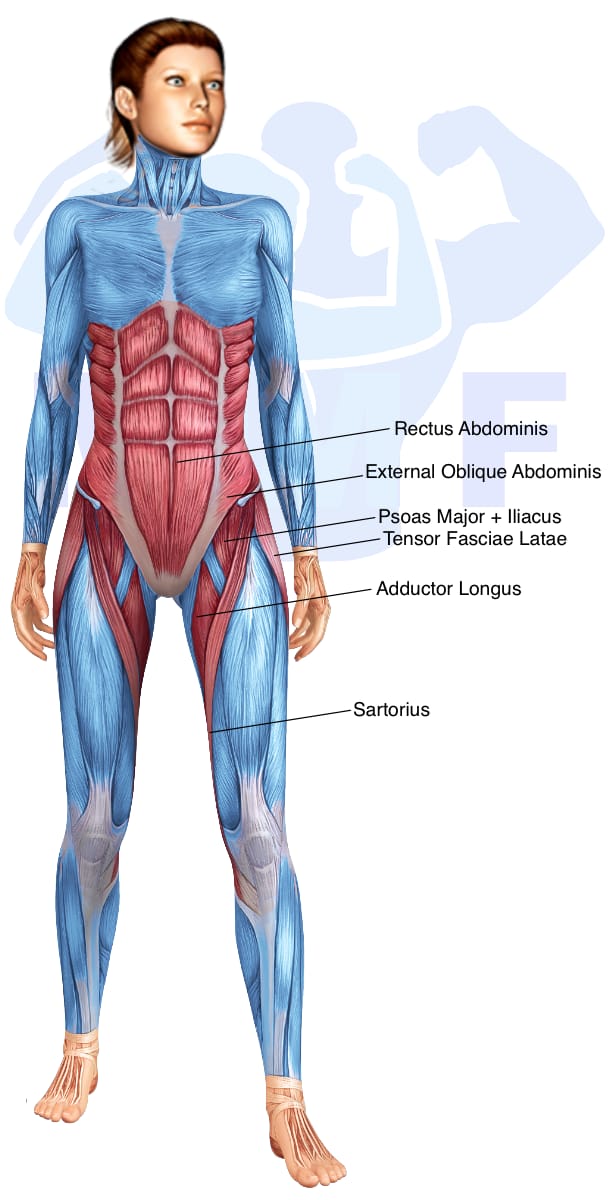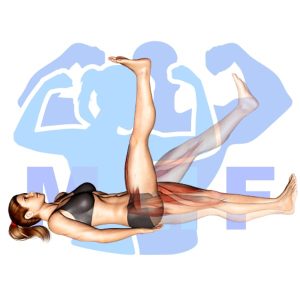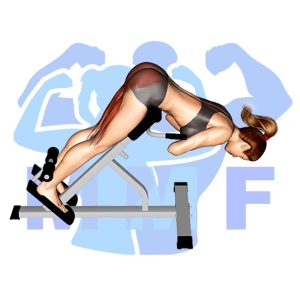Have you hit a plateau in your ab workout routine? Are you struggling to find the perfect exercise that targets your lower abs muscles? Resistance band straight leg raises might be the missing piece to your puzzle. It’s not uncommon to feel stuck in your fitness journey when you’re not challenging your muscles with new exercises. Luckily, incorporating resistance band straight leg raises into your workout can activate those stubborn lower ab muscles and help you reach your fitness goals. In this blog post, we’ll dive deeper into the benefits of resistance band straight leg raises, how to properly execute the exercise, and variations to keep your routine exciting.
Resistance Band Straight Leg Raises Summary
- Primary Muscles: Rectus Abdominis
- Secondary Muscles: Adductor Brevis, Adductor Longus, Iliopsoas, Obliques, Pectineus, Rectus Femoris, Sartorius, and Tensor Fasciae Latae
- Equipment: Resistance Band and Door Anchor
- Mechanics Type: Isolation
- Force: Push
- Utility: Auxiliary

Resistance Band Straight Leg Raises Instructions
- Secure each side of the resistance bands to each of your ankles and hook up the center of the band to a door anchor around the lower end of the door.
- Step out facing away from the anchor point until the band is nice and tight. You may need to grab a chair or wall for balance.
- Also, you can tighten the band by wrapping it around your supporting leg.
- Next, rock your weight on to your support led so that you are at a slight lean. By leaning, you are allowing your active leg to swing past and not hit the ground. For an extra calf workout you can also perform an extended calf raise on your support leg so that you won’t brush the ground.
- Execute each rep by lifting your leg out in front of you only pivoting at your hip.
- Stop the leg raise before your leg is parallel with the ground, and hold for a moment while squeezing your abs and quads.
- Now slowly swing your leg back down to the starting position.
- Repeat the leg raises for 8-12 reps and then switch legs.
Video Tutorial
Resistance Band Straight Leg Raises Muscles
Target (Agonist)
Synergists
Dynamic Stabilizers
- Rectus Femoris
Stabilizers
- Latissimus Dorsi
- Pectoralis Major – Sternal
- Pectoralis Minor
- Trapezius – Lower
Antagonist Stabilizers
- None

Benefits of Resistance Band Straight Leg Raises
The Resistance Band Straight Leg Raises is a great exercise to help build strength and endurance in the rectus abdominis muscle. This exercise helps to engage the abdominal muscles, building strength and stability throughout the core. The resistance band adds an extra challenge to the exercise, forcing the abdominal muscles to work harder to maintain good form. Additionally, because the exercise is done while lying down, it helps to reduce stress on the lower back. This makes it a great exercise for those who suffer from back pain. With consistent practice, this exercise can help to strengthen and tone the rectus abdominis, making it an effective addition to any strength training or fitness routine.
Tips for Performing Resistance Band Straight Leg Raises
If you want to get the right outcomes use these straightforward tips. Also, if you would like to minimize the chance of injuries, abide by these tips.
- Complete The Right Amount Of Sets Along With Rest. Your target initially might be to do 3 sets to near fatigue. Although, you can increase to 5 sets. If your muscles aren’t tired at the conclusion of 3 – 5, something needs to change. First, you can increase the resistance to make each rep tougher. Second, you can decrease the rest time in between each set.
- Concentrate On The Way You Breath. For this and most exercise movements inhaling and exhaling is vital. You have to be breathing out during the primary muscle contraction and breathing in when your target muscle group is expanding.
- Maintain Your Stomach Tight. For most exercises, you will need to support your back bone by flexing your abs to raise your internal pressure near your backbone.
Benefits and Tips Video
Frequent Mistakes To Avoid
You need to keep from making these general mistakes to support ideal form and improved tonning. Also
- Avoid Cheating. Most of the time, cheating is employing momentum as a substitute for the force of your target muscle tissue. Once in a while, some cheating on your last rep can be beneficial to overload your muscle, but not for more than a few reps.
- Don’t use To Little or Too Much Resistance. Too little, and you will not be sufficiently employing your agonist (target) muscle, excess, and you’ll probably cheat. Be sure you can accomplish between 8-12 reps with good technique.
Find More Resistance Band Exercises Here
Variations and Complementary Exercises
This exercise is a great way to target the muscles of the hips, thighs, and core. However, if you are looking for alternative exercises to target the same muscles, try some of the variations, complementary exercises, or alternative exercises listed below.
Resistance Band Reverse Crunch

The Resistance Band Reverse Crunch is a great complementary or alternative exercise for Resistance Band Straight Leg Raises. It works the same muscles as the Straight Leg Raises, but it also activates the lower abdominals and obliques. To do this exercise, you need to lie on your back with a resistance band around both feet. Then, slowly raise your legs off the ground while squeezing your abs and keeping your legs straight. Next, bring your knees towards your chest and then slowly lower them back to the starting position. This exercise is great for developing core strength and toning your abdominals.
Resistance Band Straight Leg Raises

Resistance Band Straight Leg Raises are an excellent alternative or complementary exercise to traditional leg lifts. This exercise can be done with a resistance band to increase the difficulty and challenge your core and lower body muscles. To perform this exercise, start by lying on your back with your legs straight and the resistance band looped around your ankles. Then, engage your core and slowly lift your legs off the floor until they are perpendicular to the floor. Hold this position for a few seconds before slowly lowering your legs back down to the starting position. By using a resistance band, you can increase the intensity of the exercise and challenge your muscles even further.
Lying Alternating Leg Raises

Lying Alternating Leg Raises are a great complementary or alternative exercise to Resistance Band Straight Leg Raises. This exercise targets the same muscle groups, but with a different approach. In this exercise, you lie flat on the ground and lift your legs alternately while keeping them straight. This exercise engages your core and strengthens your hip flexors, glutes, and lower back. Adding this exercise to your routine is a great way to target the same muscles as Resistance Band Straight Leg Raises, but in a different way.
Check Out These Top Resistance Band Exercises
Lever Lying Crunch (Machine)

The Lever Lying Crunch (Machine) is a great complementary or alternative exercise to the Resistance Band Straight Leg Raises. This exercise machine is designed to target the lower abdominal muscles, specifically the rectus abdominis, while also engaging the hip flexors and core stabilizer muscles. It is an effective exercise for strengthening and toning the abdominal area, and can be used as a supplement to the Resistance Band Straight Leg Raises for further strengthening of the core and lower body. With the Lever Lying Crunch (Machine), you can adjust the resistance to match your fitness level, making it a great way to progress your workout as you become stronger.
Legs Up Crunch

Legs Up Crunch is a great complement or alternative to the Resistance Band Straight Leg Raises. It offers a similar range of motion and can target the same muscles, while also engaging the abdominal muscles more. The exercise is performed by lying on your back with your legs in a tabletop position, then crunching your upper body up toward your legs and returning to the start position. This exercise is especially beneficial for targeting the core muscles, as well as working the glutes and hamstrings. Furthermore, it also helps to improve balance and coordination, making it a great addition to any routine.
Leg Raise Hip Lift

Leg Raise Hip Lift is an alternative exercise to Resistance Band Straight Leg Raises that focuses on the hip flexor muscles while also engaging the abdominals and glutes. To perform this exercise, begin by lying on your back with your arms out to the side and your legs in a tabletop position. Then, slowly raise your hips up until your body forms a straight line from your shoulders to your knees, and hold this position for a few seconds before lowering your hips back down. By performing this exercise, you will not only strengthen the hip flexors but also target the abdominals and glutes for increased strength and stability.
Find More Abs Exercises Here
Opposing Complementary Exercises
In addition to Resistance Band Straight Leg Raises, there are several exercises that complement this exercise by using opposing muscle groups. To maximize the benefit of Resistance Band Straight Leg Raises, try incorporating the following exercises into your routine.
Resistance Band Hyperextensions

Resistance Band Hyperextensions and Resistance Band Straight Leg Raises are complementary exercises that use opposing muscle groups. Resistance Band Hyperextensions target the back, glutes and hamstrings by having the user lie face down on the ground and use a resistance band to pull their legs up behind them while pushing their upper body off the ground. Resistance Band Straight Leg Raises target the quads and hip flexors by having the user lie on their back and lift their legs up with a resistance band around their feet. Both exercises are great for strengthening the core, improving balance and stability, and increasing flexibility.
45 Degree Hyperextension

The 45 Degree Hyperextension is a great complementary exercise to Resistance Band Straight Leg Raises. This exercise targets the lower back muscles, which work in opposition to the glutes and hamstrings targeted in the Resistance Band Straight Leg Raises. By working both of these opposing muscle groups, you can improve your overall balance, posture and strength. The 45 Degree Hyperextension is a great exercise to add to your workout routine to target your lower back muscles while also helping to strengthen and tone your glutes and hamstrings.
Straight Leg Cable Pull Through

The Straight Leg Cable Pull Through is a complementary exercise to the Resistance Band Straight Leg Raises as it works the opposing muscle group. This exercise involves standing with feet hip-width apart and holding a cable handle between the legs. From this position, the athlete then pulls the handle through the legs and stands up, using the glutes and hamstrings to do so. This exercise is great for building strength in the posterior chain and can be used to increase the intensity of Resistance Band Straight Leg Raises.
Take Your Abs to New Heights with Resistance Band Straight Leg Raises
If you’re looking to take your ab workout to the next level, resistance band straight leg raises could be just what you need. This exercise targets your lower abs, which can be tough to reach with traditional crunches or sit-ups, and also helps to strengthen your hip flexors. By using a resistance band, you add an extra challenge to the movement, helping to increase your overall strength and stability. Be sure to focus on your form and keep your movements slow and controlled to get the most out of this exercise. With consistent practice, you’ll be well on your way to rock-solid abs.
References: Wikipedia | ExRx.net | PubMed.gov | Comprehensive List of Abs Resistance Band Exercises

